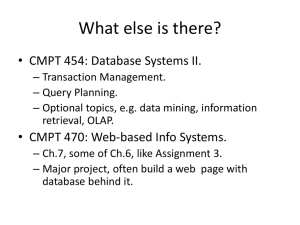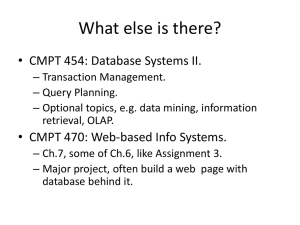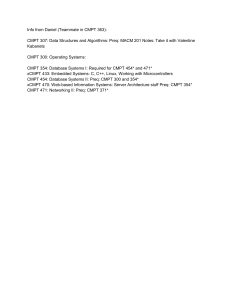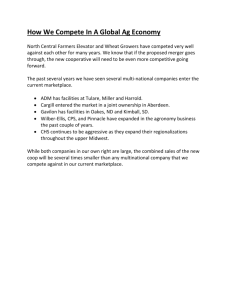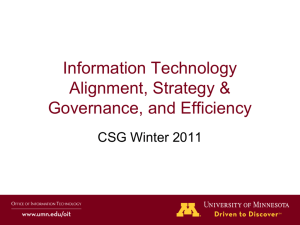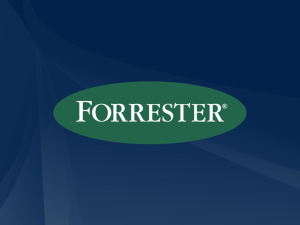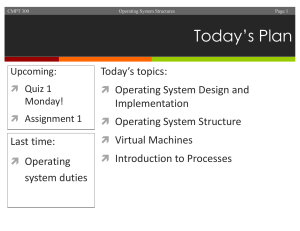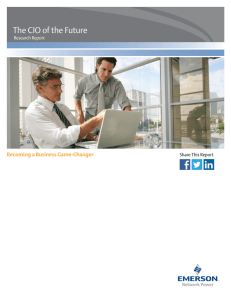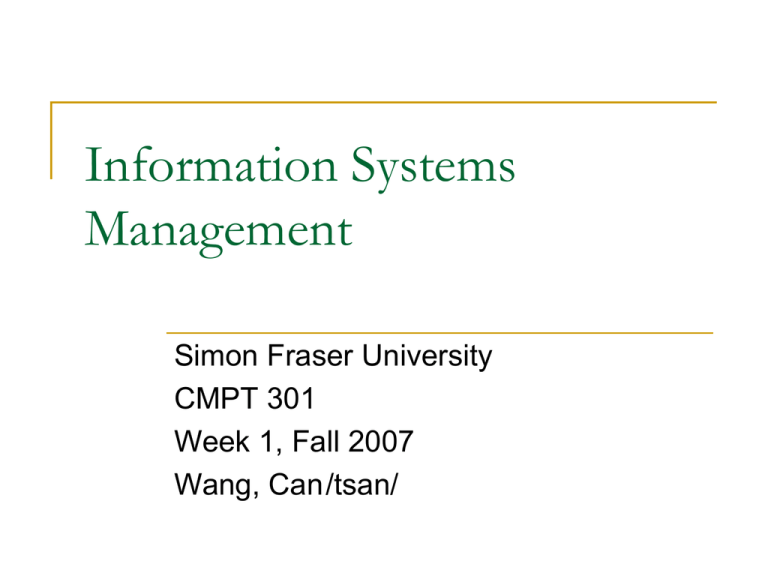
Information Systems
Management
Simon Fraser University
CMPT 301
Week 1, Fall 2007
Wang, Can/tsan/
Outline
1
Course Introduction
2 The Organizational Environment
3 The Technology Environment
4
A Framework for IS Management
CMPT 301 is about
CMPT 301 is about the management of
information technology as it is being practiced
in organizations today.
Coverage across the full spectrum of IT for
managing and operating organizations.
Guidance on the issues, strategies, and tactics for
managing the use of IT.
Why Business?
You will either be working for:
An IT Vendor
Whose customers are businesses and non-profit
organizations
Your products need to fulfill their needs
Working for a business as a IT professional
Deploying IT resources is even harder than creating
them in the first place
Servicing the IT needs of companies
Why Management Problems?
Problems are rarely just "technical"
Management problems are just as difficult to
resolve
We are very good at resolving technical problems,
not so for management problems
Partly because management problems are
sometimes harder than technical ones to define
Industry Trends
For IT Vendors
Customers demand complete solutions; not just
hardware or software.
Businesses want problems solve by IT; they don't
want problems created by IT.
For IT professionals
Employers want problem solvers; not just
programmers.
Problem solving skills can protect you from
commoditization of your technical skills
Layout of Topics (1)
Weeks 2-4:
Introduction to the strategic issues that are the
responsibility of top IT management executives (CIOs)
Evolution of IS function and the CIO's job
Strategic use of IT
IS planning
Weeks 5-9:
Management of the essential information technologies
Distributed systems architecture
Telecommunications
Corporate information resources
Managing computer operations
Layout of Topics (2)
Weeks 10-12:
Developing and delivering systems
Tools, approaches and trends of system development
Managing system development and delivery
Weeks 13: Project presentation
Grading
2 Written Case Assignments 20%
Midterm 20%
Final Group Project
Project Report 20%
Project Presentation 5%
not showing up for project presentations -2%
Final Exam 35%
Covers all materials in class
Learning Materials
Textbook
Barbara C. McNurlin, Ralph H. Sprague,
Information Systems Management in
Practice (7/e), Pearson Prentice Hall
Supplemental readings
Lectures will be on the web at (??)
Set aside about 4-6 hours per week
for CMPT 301
Class, lesson prep, assignments and
projects
Contact Info
Office Hours
Mondays 15:00-16:00 (TASC1 9241)
Thursdays 16:15-17:15 (TASC1 9241)
Office tel: 778-782-7331
My Email: cwa50@sfu.ca
TA: Jiawei Huang, jha48@sfu.ca
Outline
Course Introduction
1
2
The Organizational Environment
3 The technology environment
4
A framework for IS management
The External Business Environment
The way IT is used depends
Organizational environment
Technological advances
Major changes in our global marketplace
The Internet economy
Global marketplace
Business ecosystems &. decapitalization
Faster business cycles & accountability and
transparency
Rising societal risks of IT
The Internet Economy
From APARTNET to today’s Internet
WWW has evolved from a graphical layer of the
Internet to a cyberspace for business
B2C, e.g. Amazon.com
B2B, e.g. eBay
Dot-com crash
Pure Internet economy VS. the hybrid model
Bricks and clicks
Global Marketplace
Mergers cross the national boundaries
The entire world has become the marketplace
Internet enables companies to work globally
Even small firms have global reach
Local backlash
Global environment VS. local tastes
Business Ecosystems
An ecosystem is a web of relationships
surrounding one or a few companies
They appear to follow biological rules
Various players in one's business ecosystem
Banks, advertising agencies, suppliers, distributors,
retailers, competitors etc.
Decapitalization
Tangible items, such as capital, equipment
and buildings were the tenets of power in the
industrial age
Today, we see power of ‘intangibles’ such as
ideas and knowledge
Managing talent is now as important as e.g.
managing finance
Faster Business Cycle
& Accountability and Transparency Issues
Faster tempo of business
Less time to market
Shorter product life cycle
The rise and fall of dot-coms and telecoms
Calls for greater transparency of corporations
Increasing pressure for corporate ethics
Rising Societal Risks of IT
CIOs need to address the dark side of IT
more than ever
Network shutdowns
Computer viruses
Identity theft
Email scams
CIOs need to consider the societal effects of
outsourcing
Movement of white collar jobs offshore
The Internal Organizational Environment
Organizational structures are changing
The relationship between IT and enterprise
structure is growing more widespread and deeper
The ways people work and organizations operate
are affected by changes in the internal
organization environment
From Supply-Push to Demand-Pull
Supply-push
Companies did their best to figure out what customers
wanted
Organized to build a supply of products or services
and then ‘push’ them out to end customers on stores
shelves, in catalogs etc.
Demand-pull
Allows much closer and ‘one-to-one’ contact between
customer and seller
Offer customers the components of a product/service
then the customer creates their own version by ‘pulling’
what they want
Self- Service
ATMS FedEx
Allows customs to communicate and ‘do
business’ with the firm on their own
Real-Time Working
Sales people have up-to-the-minute
information about customers
Knowing e.g. inventory and cash levels as
the are NOW – not as they were a week or a
month ago
Being able to reach someone when you need
them
Instant messaging
Team-Based Working
Task-oriented teams
Groupware
Each member has a unique contribution to the
overall results.
Provides IT support for meeting, collaborative
work, and communication among far-flung team
members.
Anytime, anyplace information work
Outsourcing and Strategic Alliances
To become more competitive, organizations
are examining types of work that should be
done internally or externally by others
The thinking is: We should focus on what we do
best and outsource the other functions to people
who specialize in them
Ranges from a simple contract for services to a
long-term strategic alliance
Demise of Hierarchy
Hierarchical structures cannot cope with rapid
change
Communications up and down the chain of
command takes too much time for today’s
environment
Self-managed groups produce higher
performance
IT enables team-based organizational structures
by facilitating rapid and far-flung communication
Goals of the New Work Environment(1)
Leverage Knowledge Globally
Tap tacit knowledge by fostering sharing and
supporting sharing through technology
Organize for Complexity
The world is so interconnected
Issues are often systemic
Choices are endless
Goals of the New Work Environment(2)
Work Electronically
The microchip moved power within companies
Bandwidth moves power all the way to consumers
Internet provides a cyber-workspace in which
diversified choices can be accommodated
Handle continuous and discontinuous change
Innovations occurring in fits and starts
Outline
Course Introduction
1
4
2
The Organizational Environment
3
The technology environment
A framework for IS management
Hardware Trends
1950s –60s: Batch processing (mainframe)
Mid 1970s: Departmental minicomputers
1980s: Advent of PCs
Client-Server computing
"Client" machine user interfaces with "Server" on the
network holding the data and applications
Current: hand-held devices, wireless etc.
Further distribution beyond organizational
boundaries to suppliers, customers etc.
Software Trends (1)
In 1960s
In 1970s
Improve the productivity of in-house programmers
Modular and structured programming techniques
Life cycle development methodologies and software engineering
Prototyping
Purchasing software became viable alternative to in-house
development
OOA & OOP
In 1980s
IS managers paying attention to applications other than
transaction processing
DSS, report generation, database apps
End users develop their own systems
Software Trends (2)
1990s
Push for "open systems"
Enterprise Resource Planning (ERP) e.g. SAP, PeopleSoft
Like hardware, software is migrating to be network centric.
A fundamental organizational change
Defining a corporation's IT architecture
Web front ends to empower employees rather than replacing
legacy systems
Now
Moving to Web Services
Packages of code that each perform a specific function and have
a URL
The network becomes the heart of the system, linking all Web
Services
Data Trends (1)
1950s-1960s
File management
Organizing files to serve individual applications
Corporate databases
Serving several applications
Led to concept of establishing a data administration
function
Data Trends (2)
1970s
DBMS
Data dictionary/directory
Specification and format, information about relationships
among systems, sources and uses of data etc.
First 20 years: managing data in a centralized environment
Late '70s / '80s
RDBMS, 4GL and PCs:
Data distribution: employees directly access corporate
data
Data Trends (3)
1990s
From data resources to information resources
Information management focuses on concepts
Contains a much richer universe of digitized media including
voice, graphics, animation and photographs
New technologies
Data warehousing
Stores huge amounts of historical data from systems such as
retailers Point-Of-Sale systems
Data mining
Extracting knowledge from large amounts of data
Data Trends (4)
Now
Web has broadened ‘data’ to ‘content’
Text, graphics, animation, maps, photos, video etc.
Two major data issues are now facing CIOs:
Security – protecting data from those who should not
see it
Privacy – safeguarding the personal data of employees,
customers etc.
Communications Trends (1)
Telecom opened up new uses of IS so it became
an integral component of IS management
Communications-based information systems link
organizations to their suppliers and customers
Telecom has experienced enormous change
and is now taking "center stage"
Early use: online and time-sharing systems
Then: interest in both public and private (intracompany) data networks blossomed
Communications Trends (2)
Internet: changed everything!
Today the Internet's protocol has become the worldwide
standard for LANs and WANs
Will also soon be the standard for voice, TV etc.
Explosion of wireless
2nd generation, instant messaging, Wi-Fi, 3rd
generation (3G)
Doesn’t just enable mobility: changes how people
communicate, how they live and how they work
Outline
Course Introduction
1
4
2
The Organizational Environment
3
The technology environment
A framework for IS management
The Mission of Information Systems (1)
Early days: "paperwork factories" to pay
employees, bill customers, ship products etc.
MIS era: producing reports all levels of
management
“Get the right information to the right person at the
right time.” (?)
The Mission of Information Systems (2)
Today: Improve the performance of people in
organizations through the use of information
technology.
The final objective is the improvement of the
enterprise, therefore IS performance is based on
business outcomes and business results.
A Simple Model of Technology Use
In the early days of Information Systems, the
“translation” between IT and users was
performed almost entirely by systems analysts
Systems Professionals Bridging the
Technology Gap
Over the last 50 years technology has become
increasingly complex and powerful
Users have become increasingly sophisticated
Information systems are now viewed as "products" and
users have become "customers"
More specialization is required of systems
professionals to bridge this wider gap
Users Bridging the Technology Gap
Technology becomes user-friendly and many
applications are handled by non-IT staff.
Transaction systems, however, are still
developed by professional developers.
A Better Model
The Technologies
Several forces contribute to the increased
importance and complexity of IT:
Growth in capacity and reduction in cost & size
Merging of previously separate technologies of
computers, telephones/telecom/cable TV, office
equipment and consumer electronics
Ability to store and handle multiple forms of data
The Users
A dichotomy of information worker
Procedure-based activities
High volume of transactions; well-structured procedures;
output measure defined; focus on process and
efficiency; handling of data...
e.g. "Pay employees"
Knowledge-based activities
Low volume of transactions; ill-structured procedures;
output measure less defined; focus on problems, goals
and effectiveness; handling of concepts…
e.g. "improve sales in the Asian Market"
System Development and Delivery
Bridging the gap between technology and
users
Systems for procedure-based activities differ
from systems for knowledge-based
information work
Infrastructure management
Hardware and software
Telecommunications
Information resources
IS Management
Chief Information Officer (CIO)
CIOs must work with all the other CXOs
Must be high enough in the enterprise to influence
organizational goals
Must have enough credibility to lead the
harnessing of technology to pursue those goals
IT has become too important to be left to one
individual
Executive team must work together to govern
IT and leverage IT well
A Better Model

